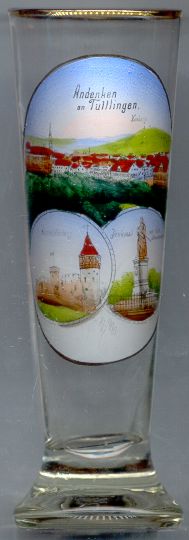

|
| DEUTSCHLAND | GERMANY |
| Bundesland: Baden-Württemberg | |
| Regierungsbezirk: Freiburg | |
| Landkreis: Tuttlingen |
 Tuttlingen is situated at an elevation of 649 m on the river Danube in southern Baden-Württemberg.
Archeological finds demonstrate that the area was inhabited at least since about 8000–5000 BC.
Celtic tribes lived in the area around 800 BC long before the region was ruled by the Romans from 56 BC onward.
The Alemanni defeated the Romans in AD 260 and founded their own settlements. The name Tuttlingen is explained as
the village of a man named "Tutilo". Abouth two centuries after the area had been christianized the place name
"tuttiliningas" is mentioned for the first time in a document of the monastery of Sankt Gallen.
Soon after that the village came in possession of the monastery of Reichenau.
Tuttlingen is situated at an elevation of 649 m on the river Danube in southern Baden-Württemberg.
Archeological finds demonstrate that the area was inhabited at least since about 8000–5000 BC.
Celtic tribes lived in the area around 800 BC long before the region was ruled by the Romans from 56 BC onward.
The Alemanni defeated the Romans in AD 260 and founded their own settlements. The name Tuttlingen is explained as
the village of a man named "Tutilo". Abouth two centuries after the area had been christianized the place name
"tuttiliningas" is mentioned for the first time in a document of the monastery of Sankt Gallen.
Soon after that the village came in possession of the monastery of Reichenau.
In 1338 Tuttlingen was granted the status of a town by the Lords of Wartenberg who sold the town to the Counts of Württemberg in 1376. As Tuttlingen was located at a strategically important location in the Danube valley the Counts of Württemberg built one of the mightiest fortresses of their country on the Honberg around 1470. During the Thirty Years' War (1618–1648) the town, which had converted to the Protestant faith in 1535, suffered heavily. In 1643 it was the site of the 'Battle of Tuttlingen', and in 1645 the Honberg fortress was destroyed by the commander of Hohentwiel.
The most devastating event in the history of Tuttlingen was the large fire of the 1st of November 1803. On that day the entire town burnt down. The town was rebuilt completely beginning in 1804 according to a rational design with rectangular, wide streets and characteristic houses in Classicistic style. At that time Tuttlingen was one of the most modern town in Württemberg and even today a great number of buildings from that period is preserved in the historic town centre. During the late 19th century Tuttlingen changed into a more industrialized town. The opening in 1867 of the first factory for surgical instruments was the origin of a trade that became decisive for the town's economy. Today Tuttlingen calls itself the "world centre of medical technology".
Since 1952 Tuttlingen has the status of a major district town (Große Kreisstadt). The neighbouring municipalities of Möhringen, Eßlingen (not to be confused with Esslingen am Neckar) and Nendlingen were incorporated into the municipality in Tuttlingen in 1972/73. Today the municipality of Tuttlingen has a population of 35,700 (2018).
The  fortress Honberg [bottom left]
was built around 1470 by Count Eberhard "im Bart" of Württemberg. The once mighty fortress served as the seat of the
regional administration and guarded the southern border of Württemberg. The fortress was finally destroyed in 1645 during the
Thirty Years' War. After the war the seat of the regional administration was moved to Balingen and so the old castle was
not rebuilt again but fell into dereliction and served as a quarry. The remaining parts of the castle were renovated in the late
19th and early 20th century and today are a beloved landmark of Tuttlingen.
fortress Honberg [bottom left]
was built around 1470 by Count Eberhard "im Bart" of Württemberg. The once mighty fortress served as the seat of the
regional administration and guarded the southern border of Württemberg. The fortress was finally destroyed in 1645 during the
Thirty Years' War. After the war the seat of the regional administration was moved to Balingen and so the old castle was
not rebuilt again but fell into dereliction and served as a quarry. The remaining parts of the castle were renovated in the late
19th and early 20th century and today are a beloved landmark of Tuttlingen.
The bottom right picture on glass no. 1725 shows the
 monument
monument
![[scale]](lineal.jpg)